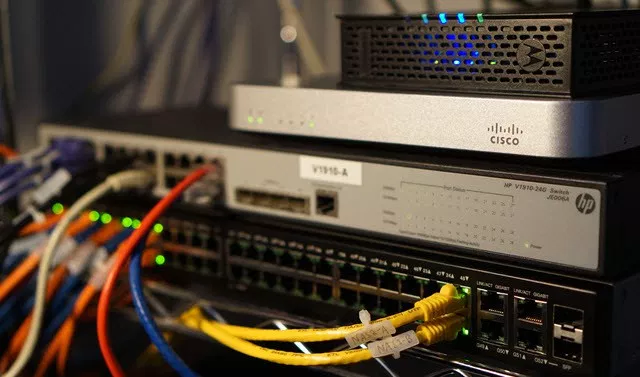 by Alan Percy, CMO @ TelcoBridges
by Alan Percy, CMO @ TelcoBridges
Universal CPE and Virtual Network Functions are seeing explosive growth in popularity with service providers, delivering SD-WAN and SIP Trunking to their multi-site enterprise customers. Our most recent monthly webinar “uCPE and VNFs Explained” describes what’s under the covers and how they work.
 Delivering services to retail stores, branch offices and other locations has traditionally resulted in a stack of networking devices in the facility network closet. You know you’ve found the right closet when faced with a stack of a network termination devices (cable, ethernet or optical terminal), a router, a firewall, VPN security, and network switch, all fixed-function devices interconnected by a tangle of ethernet cables. If you are lucky, the whole combination was installed by a pro using a 19 inch rack and carefully organized cables. Most likely not.
Delivering services to retail stores, branch offices and other locations has traditionally resulted in a stack of networking devices in the facility network closet. You know you’ve found the right closet when faced with a stack of a network termination devices (cable, ethernet or optical terminal), a router, a firewall, VPN security, and network switch, all fixed-function devices interconnected by a tangle of ethernet cables. If you are lucky, the whole combination was installed by a pro using a 19 inch rack and carefully organized cables. Most likely not.
The collection of devices is the result of conflicting cloud strategies with one initiative pushing all of the network functions and intelligence to the core of the network, while the reality of business requiring that certain functions remain at the edge of the network in the branch office. Firewall, VPN and SBC are most effective if performed at the branch office, protecting the connection within the branch. Other functions like email security and virus protection are best performed in the core of the network.
 Managing the stack of network devices by service providers and enterprises is a challenge that the Metro Ethernet Forum (now MEF) and the European Telecommunications Standards Institute (now ETSI) recognized as a cost and reliability challenge for service providers early on, developing and contributing a number of technical standards. The ETSI efforts would eventually lead to the ETSI Network Function Virtualization (NFV) Framework, a foundation for virtualized software with NFV Infrastructure, Virtual Network Functions (VNFs) and NFV Management and Orchestration (MANO).
Managing the stack of network devices by service providers and enterprises is a challenge that the Metro Ethernet Forum (now MEF) and the European Telecommunications Standards Institute (now ETSI) recognized as a cost and reliability challenge for service providers early on, developing and contributing a number of technical standards. The ETSI efforts would eventually lead to the ETSI Network Function Virtualization (NFV) Framework, a foundation for virtualized software with NFV Infrastructure, Virtual Network Functions (VNFs) and NFV Management and Orchestration (MANO).
Implementing the NFV Framework at the edge of the network requires specialized hardware that combines both a COTS compute platform, but also networking hardware with numerous physical network access points and/or physical Layer 1 interfaces. Standardized by work at the ETSI and MEF, these devices are known at Universal Customer Premise Equipment (uCPE).
With the NFV Framework and the definition of uCPE hardware, software vendors began to implement their Virtual Network Functions in a form that could fit within the framework. Firewall, router, SD-WAN and Session Border Controller (SBC) software are all network elements that are natural VNFs.
The analyst community sees great opportunity for both NFV software and uCPE hardware. Analyst firm IDC pegs the opportunity for VNFs at a $16.4 Billion market by 2022. Analyst firm HIS Markit scopes the opportunity for uCPE to a $1.02 Billion market in 2022. With AT&T and Verizon making public statements about their plans and early deployments, the remainder of the market are taking note.
 Based on early customer feedback, TelcoBridges saw early demand for SBC VNFs, offering FreeSBC and later ProSBC software as VNFs for OpenStack environments. The ProSBC VNF is used by service providers to facilitate SIP Trunking at customer branch offices, normalizing and managing network traffic. As a complementary element, Telco Systems, an Alliance Partner of TelcoBridges, offers a NFVI and MANO software suite under the brand NFVtime, providing the virtualized foundation and management capabilities for VNFs across a wide range of uCPE platforms.
Based on early customer feedback, TelcoBridges saw early demand for SBC VNFs, offering FreeSBC and later ProSBC software as VNFs for OpenStack environments. The ProSBC VNF is used by service providers to facilitate SIP Trunking at customer branch offices, normalizing and managing network traffic. As a complementary element, Telco Systems, an Alliance Partner of TelcoBridges, offers a NFVI and MANO software suite under the brand NFVtime, providing the virtualized foundation and management capabilities for VNFs across a wide range of uCPE platforms.
We explain in more detail during our recent “uCPE and VNFs Explained” webinar, presented by Gabi Podolski, NFV Product Management from Telco Systems and me. Gabi and I will be at the MEF19 event – book an appointment for a meeting
You can view a recording of the webinar on the TelcoBridges YouTube channel and/or download the slides from SlideShare.
As always, we’re happy to take your questions and appreciate your feedback, drop me an email at alan.percy@telcobridges.com

